We may not have the course you’re looking for. If you enquire or give us a call on 01344203999 and speak to our training experts, we may still be able to help with your training requirements.
Training Outcomes Within Your Budget!
We ensure quality, budget-alignment, and timely delivery by our expert instructors.
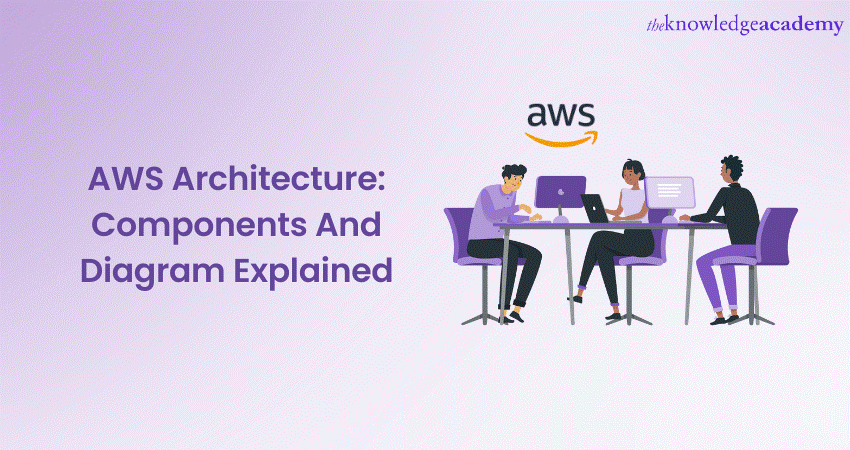
Computing has become one of the most in-demand technologies for businesses today. By arming organisations with the flexibility and scalability needed to thrive in a rapidly changing environment, Cloud Computing solutions are not only saving time but also are also ensuring excellent service and timely delivery. AWS Architecture offered by Amazon Web Services (AWS), is leading this pack with its highly secure and reliable framework.
AWS Architecture’s dominance is reflected in this Statista report as well, according to which AWS Architecture has a massive 32 per cent market share. This percentage is projected to grow in the coming years. If you want to learn more about this gigantic juggernaut, look no further.
This blog will explore AWS Architecture's definition, key components, design principles, architecture patterns, challenges, and more.
Table of Contents
1) What is AWS Architecture?
2) Key components of AWS Architecture
3) Benefits of using AWS Architecture
4) Design Principles for AWS Architecture
5) Top 5 pillars of AWS Well-Architected Framework
6) Conclusion
What is AWS Architecture?
AWS Architecture refers to the design and structuring of applications and systems built on the Amazon Web Services platform. It involves the arrangement and interconnection of various AWS services to create a robust and scalable infrastructure that can support the needs of a business or application.
The importance of AWS Architecture lies in its ability to provide a foundation for building reliable, secure, and highly available applications. By leveraging AWS services and following architectural best practices, organisations can optimise their infrastructure, achieve cost savings, and ensure seamless scalability.

What is AWS Architecture Diagram?
The fundamental framework of AWS EC2, or Amazon Web Services Elastic Compute Cloud, empowers clients to configure and utilise a variety of settings tailored to their specific project needs. This includes an array of attractive features like pricing options, individual server mapping, and server configuration.
In the AWS Architecture, Simple Storage Services (S3) allows users to access effortlessly and store data across various formats using Application Programming Interface (API) calls. Notably, no computing element required for these services.
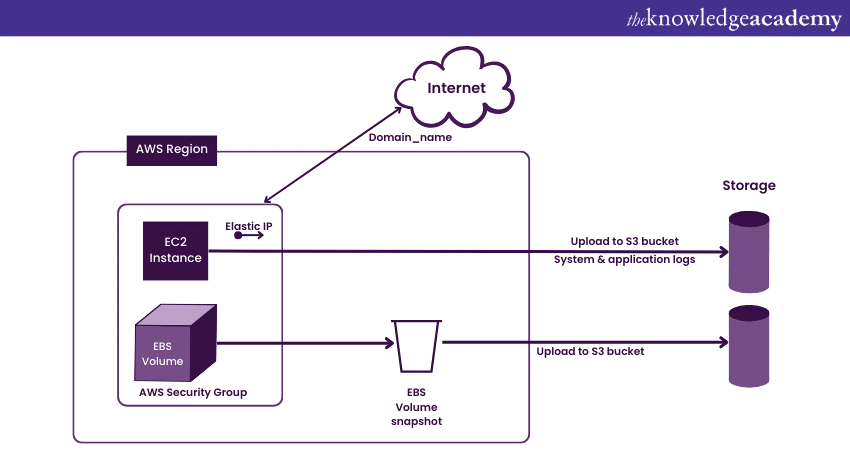
As seen in the image above, an AWS Architecture Diagram is a visual representation of the components and relationships of an AWS solution. It is a tool for communicating and documenting soluation's design, deployment, and topology of the solution. AWS Architecture Diagrams can be used to put forth the solution to stakeholders, to help troubleshoot problems, and to plan for future changes. AWS Architecture Diagrams typically include the following components:
a) AWS services: The AWS services that are used in the solution, such as Amazon EC2, Amazon S3, and Amazon RDS.
b) Resources: The resources that are created within each AWS service, such as EC2 instances, S3 buckets, and RDS databases.
c) Relationships: The relationships between the components, such as the flow of dataflows between resources or the dependencies between services.
AWS Architecture Diagrams are created using a various of tools, such as diagramming software, whiteboarding tools, or even hand-drawn sketches. The best tool for creating an AWS Architecture Diagram depends on the solution's complexity and the diagram's audience.
Enhance your AWS Architecture skills with Architecting on AWS Associate Certification Training.
Key components of AWS Architecture
AWS Architecture comprises several key components that work together to form a comprehensive and efficient system. Let's explore some of the essential components:
Load Balancing
Load Balancing is a crucial component in the AWS Architecture, enhancing the efficiency of applications and servers. In the visual representation of AWS Architecture, the hardware Lload Balancer is commonly used as a network appliance to optimise the performance of traditional web applications. This Load Balancer ensures the distribution of traffic to EC2 instances from various sources and accommodates dynamic additions and removals of Amazon EC2 hosts from the Load Balancing rotation.
Elastic Load Balancing
Elastic Load Balancing is a feature that allows for dynamic adjustment of Load Balancing capacity to meet varying traffic demands. It supports sticky sessions and provides advanced routing services.
Amazon Cloud Front
Amazon Cloud Front primarily serves as a content delivery platform for websites. It delivers various types of content, such as static, dynamic, and streaming content, using a global network of locations. Content is automatically requested from the nearest location, which greatly improves performance. There are no monthly commitments or contracts.
Elastic Load Balancer
Elastic Load Balancer directs traffic to web servers, significantly improving performance. It can dynamically scale and adjust Load Balancing capacity based on traffic conditions.
Security Management
Security Management includes security groups, which function as inbound network firewalls. These groups specify the ports, protocols, and source IP ranges that can access EC2 instances. AWS Security groups can be configured using specific subnets or IP addresses to effectively limit access to EC2 instances effectively.
Elastic Cache
Amazon Elastic Cache is a cloud-based web service that manages memory caching efficiently. It plays a crucial role in Memory Management and alleviates the service load, enhancing performance and scalability for database tiers by caching frequently used information.
Amazon Relational Database Service (RDS)
Amazon Relational Database Service offers access to database engines like MySQL, Microsoft SQL Server, and Microsoft SQL. It is compatible with various applications, queries, and tools, making it a versatile solution within Amazon RDS.
Advantages of using AWS Architecture
AWS Architecture provides various advantages for businesses and organisations that want to create scalable, reliable, and efficient applications on the platform. Here are four main advantages of using the AWS Architecture:
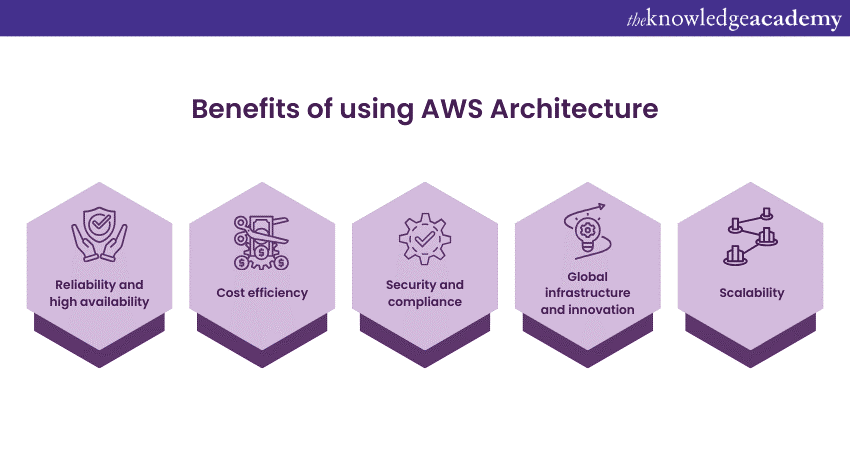
a) Built-in features: AWS has a strong infrastructure with built-in redundancy and availability features. You can use Multi-Availability Zone (AZ) deployments to spread your applications across multiple data centres, reducing the risk of downtime and ensuring high availability. Services such as Elastic Load Balancer (ELB) help balance traffic evenly and efficiently, improving the reliability of your applications.
b) Pay-as-you-go: AWS Architecture allows cost optimisation through different methods. You can use services such as AWS Lambda and serverless Architecture to pay only for the actual usage of resources, avoiding the need for upfront investments in hardware or fixed infrastructure costs. AWS also offers tools and features for cost monitoring and resource optimisation, helping you find cost-saving opportunities and optimise your spending.
c) Ensures data privacy: AWS priortises gives priority to security and compliance, offering various security features and services. AWS Architecture has built-in security controls, encryption capabilities, and Identity and Access Management tools to protect your infrastructure and data. AWS follows industry standards and regulations, providing a secure foundation for your applications and ensuring data privacy and integrity.
d) Lowers latency: AWS has a worldwide network of data centres located strategically in different regions. This global infrastructure enables you to deploy your applications closer to your users, lowering latency and enhancing performance. AWS also constantly innovates and introduces new services, enabling you to use the latest technologies and stay ahead of the competition.
e) Scalable applications: Scalability is a key feature of AWS Architecture, which means that it can easily adapt to the changing requirements of your business. This feature is enabled by the wide range of services offered by AWS Blockchain that facilitate the creation of scalable applications. These services include Auto Scaling, Elastic Load Balancing, and Cloud Front, which enable you to adjust your infrastructure to meet changing demands smoothly.
Design Principles for AWS Architecture
To ensure the effectiveness and efficiency of AWS Architecture, it is crucial to adhere to certain design principles. Listed below are some fundamental principles to consider:
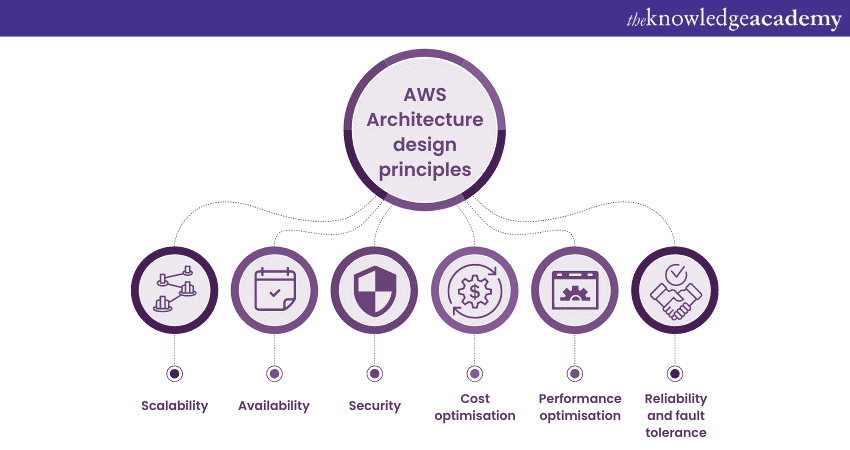
a) Scalability: Scalability is a fundamental aspect of AWS Architecture. By designing your applications to scale horizontally or vertically, you can handle increased workloads and accommodate growth without compromising performance. AWS offers services like Auto Scaling, which allows you to adjust the capacity of your resources automatically based on demand, ensuring your applications can seamlessly handle fluctuations in traffic.
b) Availability: AWS provides various services and features to enhance the availability of your applications. Leveraging these features can help you minimise downtime and ensure your applications remain accessible to users at all times. Elastic Load Balancer (ELB) automatically distributes incoming traffic across multiple instances, further enhancing availability.
c) Security: Security should always be a top priority when architecting your applications on AWS. AWS offers a wide range of security features and services to help you protect your infrastructure and data from unauthorised access and potential threats. Security measures such as identity and Access Management, encryption, and network isolation can ensure your resources’ confidentiality, integrity, and availability of your resources. Regularly auditing your systems and staying updated with the latest security best practices is crucial to maintaining a secure AWS Architecture.
d) Cost optimisation: Optimising costs is important when designing your AWS Architecture. You can achieve cost savings by leveraging AWS services efficiently and right-sizing your resources without sacrificing performance. Implementing cost control mechanisms such as monitoring and resource tagging can help you track and manage your costs effectively. AWS also provides services like AWS Cost Explorer and AWS Budgets to help you visualise and analyse your cost usage, allowing you to make informed decisions and optimise your spending.
e) Performance optimisation: AWS offers various features and services to optimise the performance of your applications. Leveraging caching mechanisms, Content Delivery Networks (CDNs), and optimised database configurations can significantly enhance the responsiveness and speed of your applications. It's essential to analyse your application's performance requirements and choose the appropriate AWS services and configurations to achieve optimal performance.
f) Reliability and fault tolerance: Designing your AWS Architecture for reliability and fault tolerance is essential to ensure the resilience of your applications. AWS provides services like Amazon S3 for durable storage, Amazon RDS for automated backups and recovery, and Amazon Route 53 for reliable DNS Management. Implementing strategies such as data replication, backup and restore mechanisms, and automatic recovery processes can minimise the impact of failures and ensure high availability.
Don't miss our handpicked AWS Interview Questions and Answers from our Expert team to crack Interviews Easily.
Top 5 pillars of AWS Well-Architected Framework
The AWS Well-Architected Framework is designed in a way that helps complete projects with ease by following five key pillars:
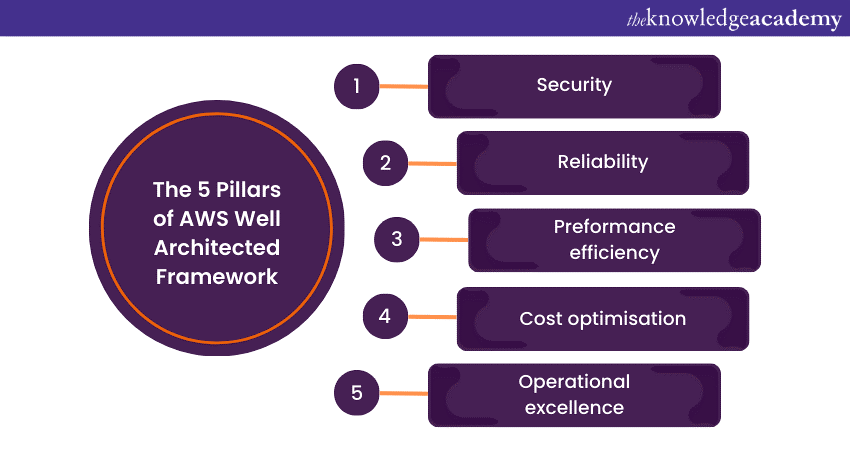
Security
In AWS Architecture, security is paramount. It involves designing infrastructure that provides:
a) Comprehensive data protection
b) Infrastructure security
c) Privilege Management across all AWS accounts
d) Ability to identify security breaches through detective controls
The design principles for security include applying security measures at every level, implementing the Principle of Least Privilege, enabling traceability, securing system applications, data, and Operating Systems (OS), and automating security best practices.
Reliability
AWS Architecture is built on a solid foundation with monitoring and mechanisms to handle varying demand rates effectively. The system should be able to detect failures and provide optimised solutions. Fundamental design principles for reliability include testing recovery procedures, using horizontal scalability to increase system availability, automatic recovery from failures, adding or removing resources as needed, and managing changes through automation.
Performance efficiency
This pillar emphasises the efficient use of computing resources to meet requirements and maintain efficiency as demand fluctuates and technology evolves. Design principles for performance efficiency include:
a) Democratising advanced technologies.
b) Globally deploying systems at minimal latency costs.
c) Using serverless architecture to reduce operational burdens.
d) Conducting comparative testing and configurations for improved performance.
Cost optimisation
Cost optimisation is a fundamental pillar of AWS Architecture, focusing on optimising costs by eliminating unused or suboptimal resources and matching supply with demand. Design principles for cost optimisation involve:
a) Adopting a consumption model.
b) Leveraging economies of scale.
c) Ceasing investments in data centre operations.
d) Analysing and attributing expenditures.
e) Using well-managed services to reduce the total cost of ownership.
Operational excellence
Operational excellence encompasses reliability, agility, and performance. It involves standardising and efficiently managing workflows. A few basic principles for operational excellence include:
a) Performing operations with code.
b) Making regular incremental changes.
c) Testing responses to unexpected events.
d) Learning from events and operational failures.
e) Ensuring that operational procedures are up to date.
Become an expert on running and monitoring systems to drive business value with our AWS Professional DevOps Engineer Training today!
Conclusion
AWS Architecture is pivotal in building scalable, reliable, and secure applications on the Amazon Web Services platform. Businesses can leverage AWS Architecture to optimise their infrastructure, enhance performance, and achieve business goals by understanding the key components, design principles, benefits, and limitations
Take your AWS skills to the next level with our AWS Certification Training. Register now!
Frequently Asked Questions

AWS Architecture enables hybrid and multi-cloud solutions for organisations with various infrastructure needs. It offers smooth integration, elastic services, and safe connection across different environments, such as on-premises, at the edge, and other clouds. This flexibility improves organisational speed and resource optimisation.

Cost and performance optimisation in AWS Architecture can be achieved by carefully tracking resources, choosing the right instances, using spot instances, applying Auto Scaling, using AWS Cost Management tools, and following well-architected frameworks. These practices improve efficiency and cost-effectiveness in deployments.

The Knowledge Academy takes global learning to new heights, offering over 30,000 online courses across 490+ locations in 220 countries. This expansive reach ensures accessibility and convenience for learners worldwide.
Alongside our diverse Online Course Catalogue, encompassing 17 major categories, we go the extra mile by providing a plethora of free educational Online Resources like News updates, Blogs, videos, webinars, and interview questions. Tailoring learning experiences further, professionals can maximise value with customisable Course Bundles of TKA.

The Knowledge Academy’s Knowledge Pass, a prepaid voucher, adds another layer of flexibility, allowing course bookings over a 12-month period. Join us on a journey where education knows no bounds.

The Knowledge Academy offers various AWS Certification Courses, including AWS Certification Practitioner, AWS Associate Solutions Architect and AWS Professional Solutions Architect Training. These courses cater to different skill levels, providing comprehensive insights into AWS Projects.
Our Cloud Computing Blogs cover a range of topics related to AWS, offering valuable resources, best practices, and industry insights. Whether you are a beginner or looking to advance your AWS skills, The Knowledge Academy's diverse courses and informative blogs have you covered.







 Top Rated Course
Top Rated Course



 If you wish to make any changes to your course, please
If you wish to make any changes to your course, please


